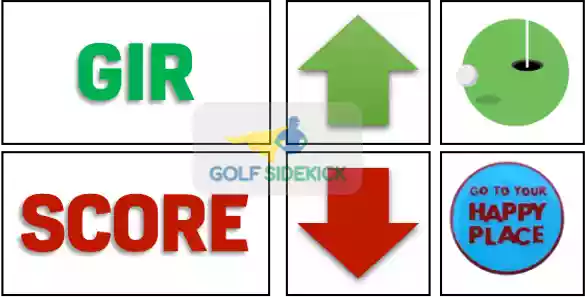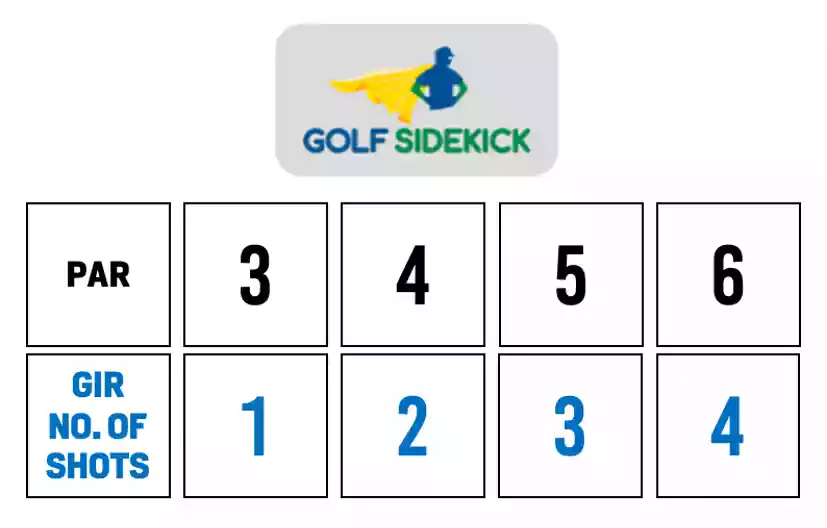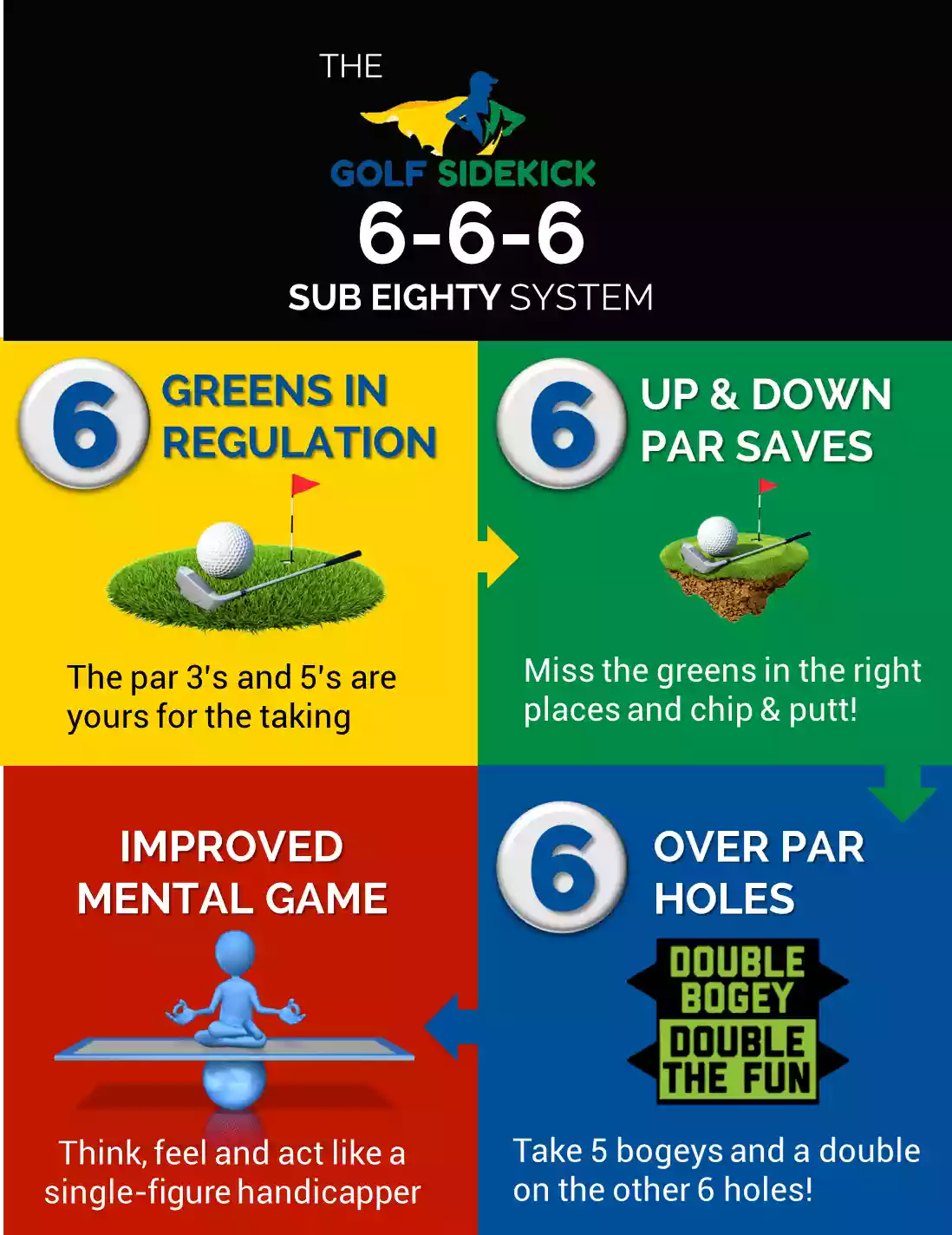Last Updated on December 26, 2023 by Matt Greene
Many amateur golfers and recreational golfers have heard GIR or Green in Regulation used but might not fully grasp its meaning. It's important to understand what is a GIR in golf so you can plan the holes during your round for lower scores. Let’s dive into this term and see how it could impact your own game.

Greens in Regulation Meaning
In golf, a player hits a green in regulation when their golf ball hits and remains on the putting surface of a hole in 2 shots less than the par of the hole on the scorecard.
Par is the number of strokes a scratch player is expected to score on a given hole. The par rating is loosely linked to a hole’s length but their are other factors involved. For example, on a par four, an expert player is expected to take two shots to hit the putting surface, then two putts to get the ball into the hole.
With this definition of par set, we can now work out the green in regulation for each par rating. It’s simple subtraction based on the two putts we assume an expert player will take to get the ball into the hole once they’re on the putting surface.
- Par 3 – An expert or professional player would be expected to hit the green with their tee (first) shot.
- Par 4 – Our player must hit the green with their second shot.
- Par 5 – The player has to get the ball onto the dance floor with their third shot.
For the green in regulation stat to be met, the ball must remain on the putting surface. It cannot be on the fringe or in the greenside rough. This stat puts a premium on ball striking and accuracy.
If a golfer hits the par 4 green in ONE shot, or a par 5 in TWO shots, he is considered on the green in UNDER REGULATION.

For high-handicappers, obtaining a GIR is a real achievement. As you get better at the game of golf, you will most likely see your GIR percentage improve over time. Tracking these stats can be done in a number of ways. The basic way is to mark a GIR on your scorecard and then add them up at the end of each round. The most common way for many golfers is to use a golf stat tracking app, either on your mobile phone or through a golf watch.
If you hit a green in regulation, you have a better chance of making a birdie and if under regulation, an eagle.
When is a golf ball considered on the green?
According to the USGA, Your ball is on the putting green. when any part of it: Touches the putting green.
A little bit of the ball must touch the green. Then you can mark it and clean as normal on the putting green. Some of your ball can even be touching the fringe, but if it is also touching the green surface, you are considered on the green.
Does fringe count as a green in regulation?
No, the fringe does not count as green in regulation. This does not mean you cannot use your putter to hit the ball. You should put the wedge or iron away and instead, putt the ball from the fringe for lower scores. Easy game!
What is a Good GIR Percentage?
A good green in regulation percentage is anything above 33% as an amateur which is 6 greens in regulation. Of course, GIR will depend on your handicap but any number of greens in regulation is good for most amateurs. A good GIR percentage for low handicappers is more than 50%.
How can I hit more greens in regulation?
Now that we know what this term means, how can we hit more greens in regulation? The PGA tour record is 69 out of 72 holes in a tournament, do you think you could match that?
Target par 3s
Par 3’s are the shortest holes on the golf course and present an opportunity to hit the green in regulation. You will be able to tee the ball up which will help you make clean contact with the golf ball and increase your chances on hitting the green with your first shot. Generally speaking, club selection on par 3s is limited so it reduces the complexity of the shot. Even a newer golfer could expect to hit a green in regulation with a shorter golf club in hand.
Get in play on par 4s
If you’re hitting your approach shots from the deep rough, you don’t have a realistic shot at hitting the green in regulation as an amateur golfer. Driving accuracy is key here. Most golfers choose the wrong club to hit from the tee box, so pick one which gives you confidence. You want your approach shot to give you the best chance on getting on the putting surface with your second shot. Remember to aim away from hazards like fairway bunkers. The more fairways hit the higher your GIR percentage will be.
Learn to hit it long! (strokes gained)
The big difference between amateur golfers and professional golfers is the distance they hit the golf ball. Hitting a par 5 green in regulation is much more achievable for pga tour players as they will be able to hit the green with their second stroke or be green side in two, leaving a short chip or approach shot into the green. Most amateur golfers will be hitting a longer club in the the green and will need to have good accuracy and distance control to hit the green in three shots.
By learning to hit the ball further, you are statistically increasing your chances of hitting greens in regulation BUT you must retain a high level of accuracy. Those who chance distance and only distance will sacrifice their short game and touch on the putting green.
Yes PGA tour pros like Tiger Woods and Rory McIlroy can bomb it way past the everyday golfer, but they balance this distance with supreme short game skill. This strokes gained approach has become very popular in recent times but I don’t think it applies to average golfers.
GIR by handicap - greens in regulation stats
The scratch player is expected to hit the greens in regulation according to the par on the scorecard. As we described above, 1 shot on a par 3, 2 shots on a par 4 and 5 shots on a par 5.
It's very very rare for even a pro golfer to hit all 18 greens in a round. Scratch golfers may hit a few less than a professional and mid handicappers to high handicappers are all much less than that.
Below is a table of expected GIR by handicap
Greens in Regulation percentage by handicap level
- 24+ handicap = 0 to 2 greens
- 18 to 24 handicap = 1 to 3 greens
- 12 to 18 handicap = 3 to 6 greens
- 9 to 12 handicap = 4 to 7 green
- 6 to 9 handicap = 5 to 8 greens
- 3 to 6 handicap = 6 to 9 greens
- 0 to 2 handicap = 8 to 12 greens
- +3 to +1 handicap = 10 to 13 greens
- Tour average: 11.7 greens
| Greens in regulation are definitely a goal for most golfers. Understand that if you hit more greens in regulation, you may take more putts because you will be two-putting more instead of chipping and one-putting. Missing greens in regulation and three putting can bring on more bogeys and double bogeys. |
Average GIR Percentage on the PGA Tour
The average GIR percentage on the PGA Tour is 65% according to the PGA Tour Stats section. In 2021, Cameron Percy was the best and he hit 72% of greens while Martin Trainer hit only 55% at the bottom of the rankings.
PGA Tour Approach Shot Statistics (GIR Percentage) by distance of approach
Here we look at the green in regulation of PGA Tour pros from each distance taken from the PGA Tour Approach The Green Stats page:
200+ yards - 40% of greens. When pros hit the green from 200 or more yards, proximity to the hole is between 43 and 54 feet from the cup. This should give you hope! If you’re over 200 yards from the hole and hit the green, that's good because Tour Pros hit less than half!
175-200 yards - 53% of greens. Inside 200 yards, PGA Tour golfers hit just about half the greens with an average of 34 feet from the hole.
150-175 yards - 63% of greens. From 9 iron to 7 iron range, Tour pros hit another 1 out of 10 greens more the above and hit it a bit closer to the hole: 27 feet from the hole.
125-150 yards - 69% of greens. Despite this being GW to 9 iron range, pros hit it 23 feet away from the cup! This may sound surprising and it is. But it also means we should be less fussy when we do hit a green with our GW PW or 9 iron. Sometimes we get annoyed because we are not 6 feet from the hole!
100-125 yards - 74% of greens. Average proximity to the hole is 20 feet with a sand wedge, gap wedge or pitching wedge.It is surprising to see pros hit only 3 out of 4 greens from here but the pins are put in the most difficult positions on the greens!
Less than 100 yards - 81% of greens. Pros hit the ball to about 17 feet from the short range inside their sand wedge zone. If you can attain 80% of greens every time you have a shot below 100 yards into the green, you will be an elite player!
How many greens in regulation to break 80?
To break 80, you only need 6 or 7 greens in regulation. According to Golf Sidekick Triple 6 Sub 80 System, you only need 6 greens in regulation, and 6 up and downs to break 80 easily.

Conclusion
Hitting greens in regulation for recreational golfers can be a way to lower your scores, but it’s not the only stat to focus on. You hit the green but be far from hole and if your putting isn’t up to scratch, then you might end up with a worse score than in if you hit it pin high onto the fringe. Bring down your putting average, hit more fairways and more GIR will become a reality.
